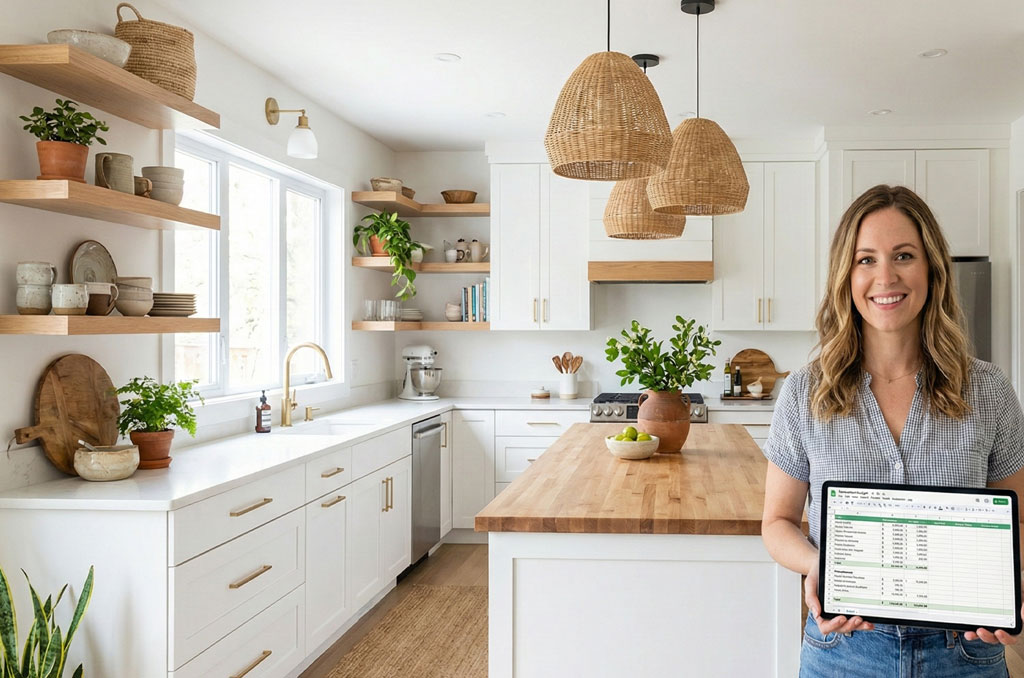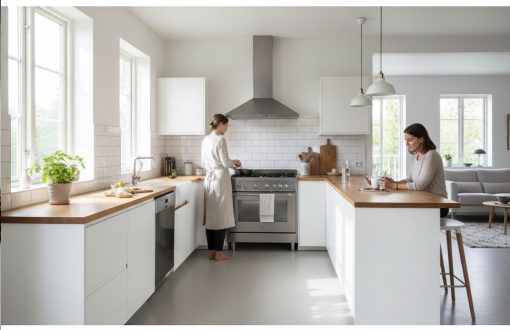7 Ways to Save Money on Your Kitchen Remodel

Top 7 Ways to Save Money on Your Kitchen Remodel
The kitchen is often called the heart of the home for a good reason. It is where we make our morning coffee, help kids with homework, and catch up with friends over dinner. Because we spend so much time there, it is only natural to dream about making it look beautiful and function perfectly. However, as soon as you start looking at price tags for cabinets and countertops, that dream can quickly feel like a financial nightmare. The good news is that you do not need a celebrity budget to create a space you love.
 A successful kitchen remodel doesn’t always mean tearing everything down to the studs and starting from scratch. In fact, some of the most stunning transformations happen when homeowners get creative with what they already have. By making strategic choices and prioritizing where your money goes, you can achieve a high-end look for a fraction of the cost. It is all about knowing where to splurge and where to save.
A successful kitchen remodel doesn’t always mean tearing everything down to the studs and starting from scratch. In fact, some of the most stunning transformations happen when homeowners get creative with what they already have. By making strategic choices and prioritizing where your money goes, you can achieve a high-end look for a fraction of the cost. It is all about knowing where to splurge and where to save.
In this guide, we are going to walk through seven practical, proven strategies to keep your budget in check without sacrificing style. Whether you are planning a minor refresh or a major overhaul, these tips will help you navigate your kitchen remodel with confidence. Let’s dive into how you can get the kitchen of your dreams without emptying your savings account. Before starting your remodel, you can also use simple 3D home design tools to preview materials and layouts. It helps you avoid costly mistakes. You can read our full guide here: How to Use 3D Home Design to Save Money on Renovations.
1. Refresh Cabinets Instead of Replacing Them
One of the most shocking numbers you will see on any renovation estimate is the cost of new cabinetry. Replacing cabinets can easily eat up thirty to fifty percent of your entire renovation budget. If your current cabinet boxes are physically sturdy—meaning the wood isn’t rotting and the shelves aren’t sagging—you have a golden opportunity to save thousands of dollars. Instead of ripping them out and sending them to a landfill, consider giving them a facelift. It is like giving your kitchen a brand-new outfit without buying a whole new wardrobe.
Painting is the most cost-effective way to transform your cabinets during a kitchen remodel. A coat of crisp white paint can make a dark, cramped kitchen feel bright and airy, while a deep navy or sage green can add modern sophistication. If you are willing to put in some elbow grease, you can sand and paint them yourself. If DIY isn’t your style, hiring a professional painter is still significantly cheaper than buying new boxes. Think of it as the difference between buying a brand-new car and just getting a really good detail and paint job on the one you have—it looks new to everyone else, but you kept the reliable engine underneath.
If painting feels too simple, you can take it a step further by refacing. This involves keeping the cabinet boxes exactly where they are but replacing just the doors and drawer fronts. You then apply a matching veneer to the exposed frames. This gives you the exact style of a brand-new custom kitchen—whether you want Shaker style or flat-panel modern—but you avoid the heavy labor and material costs of tearing out the old units. It is a smart compromise that tricks the eye completely.
2. Keep Your Current Layout Intact
 When you watch home renovation shows on TV, the first thing they usually do is knock down walls and move the sink to the other side of the room. While this looks dramatic, it is also the fastest way to blow your budget. Moving plumbing, gas lines, and heavy electrical wiring requires licensed professionals, permits, and a lot of labor hours. Every time you decide to move a sink, dishwasher, or stove, you are essentially paying to open up your floors and walls, which adds zero visual value to the finished room. If you’re not sure whether your current layout is efficient, you can check out our guide on choosing the most functional kitchen layout here: How to Choose the Right Layout for Your Kitchen.
When you watch home renovation shows on TV, the first thing they usually do is knock down walls and move the sink to the other side of the room. While this looks dramatic, it is also the fastest way to blow your budget. Moving plumbing, gas lines, and heavy electrical wiring requires licensed professionals, permits, and a lot of labor hours. Every time you decide to move a sink, dishwasher, or stove, you are essentially paying to open up your floors and walls, which adds zero visual value to the finished room. If you’re not sure whether your current layout is efficient, you can check out our guide on choosing the most functional kitchen layout here: How to Choose the Right Layout for Your Kitchen.
To save massive amounts of money on your kitchen remodel, try to work with the “footprint” you already have. The footprint refers to the placement of your appliances and plumbing fixtures. Unless your current layout is completely dysfunctional—like if you literally cannot open the oven door without hitting the fridge—keep the major players where they are. You can make the space feel brand new by changing the aesthetics (counters, backsplash, colors) rather than the mechanics.
Think of your kitchen’s layout like the skeleton of a body. Changing the skin and clothes (the decor) is easy and affordable, but rearranging the bones (the pipes and wires) is major surgery. By keeping the sink and stove in their original spots, you avoid the “invisible costs” of construction. You won’t see that money in the final product, but you will definitely feel it leaving your bank account. Save that cash for things you can actually see and enjoy, like a beautiful faucet or better lighting.
3. Choose Open Shelving Over Upper Cabinets
If your cabinets are too damaged to save and you absolutely must buy new ones, consider skipping the upper cabinets entirely. Upper cabinets are surprisingly expensive because they require a lot of material and precise installation. A trendy and budget-friendly alternative is to install floating open shelves. This entails removing the heavy boxes on the wall and replacing them with simple, sturdy planks of wood or metal.
Open shelving creates a sense of openness and airiness that is very popular in modern design. In smaller kitchens, upper cabinets can sometimes make the room feel closing in or claustrophobic. By switching to shelves, you visually expand the space, making the room feel larger and brighter. It allows you to display your nice dishes, cute mugs, or potted plants, turning your storage into part of the decoration. It forces a bit of organization, but the visual payoff is huge.
From a financial standpoint, the difference is stark. A standard upper cabinet might cost several hundred dollars per unit, whereas a high-quality wood shelf might cost a fraction of that. During your kitchen remodel, you could potentially save over a thousand dollars just by using shelves on one or two walls. This savings can then be redirected to buying better lower cabinets or a higher-quality countertop, balancing out the budget perfectly.
4. Be Smart About Countertop Choices
 Countertops are the jewelry of the kitchen; they are the first thing people notice, and they take a lot of wear and tear. Everyone loves the look of marble or high-end quartz, but the price per square foot can be eye-watering. However, you don’t have to settle for ugly surfaces just to save money. Today’s high-definition laminate countertops are nothing like the ones from the 1980s. They can mimic the look of granite or wood so well that you have to touch them to tell the difference, and they cost significantly less.
Countertops are the jewelry of the kitchen; they are the first thing people notice, and they take a lot of wear and tear. Everyone loves the look of marble or high-end quartz, but the price per square foot can be eye-watering. However, you don’t have to settle for ugly surfaces just to save money. Today’s high-definition laminate countertops are nothing like the ones from the 1980s. They can mimic the look of granite or wood so well that you have to touch them to tell the difference, and they cost significantly less.
Another fantastic option for a budget kitchen remodel is butcher block. Wood countertops add warmth and texture to a kitchen that stone simply cannot provide. They are much more affordable than stone and can be installed by a handy homeowner, saving on labor costs. While they do require some maintenance, like oiling them occasionally to keep them waterproof, they age beautifully and give a homey, welcoming vibe that fits many design styles, from farmhouse to modern industrial.
If your heart is absolutely set on stone, try visiting a stone yard and asking for “remnants.” Remnants are the leftover pieces from huge slabs used in other people’s big projects. If you have a smaller kitchen or just need a piece for an island, you can buy these leftovers at a steep discount. It is like buying designer fabric from the scrap bin—you get the luxury material without the luxury price tag. Mixing materials is also a great look; you could use a remnant piece of quartz for the island and affordable butcher block for the perimeter counters.
5. Keep or Thrift Your Appliances
It is very tempting to want a suite of shiny, matching professional-grade appliances when you redo a kitchen. But ask yourself: does your current oven still bake cookies evenly? Does the fridge still keep the milk cold? If the answer is yes, keep them! There is no rule that says a kitchen remodel must include new machines. You can clean them up thoroughly, and once the rest of the kitchen is updated, your old appliances might actually look better because they are surrounded by fresh design elements.
If your appliances are broken or truly hideous, you still don’t need to pay full retail price. Look for “scratch and dent” stores or outlet centers. These shops sell brand-new appliances that have a small cosmetic ding on the side or back—places where no one will ever see them once they are slid between cabinets. You can get a top-of-the-line refrigerator for half off just because it has a scratch on the side panel that will be hidden by a wall anyway.
Another strategy is to buy used. Many people renovate perfectly good kitchens just because they want a style change, and they sell their working appliances on online marketplaces for cheap. If the color of your appliance is the only problem (like an old almond-colored dishwasher), you can even buy special appliance paint or stainless steel stylistic peel-and-stick covers. This helps you achieve a cohesive look without the massive expense of buying new units.
6. DIY the Simple Stuff, Hire Pros for the Rest
 Labor costs can double the price of a renovation. To keep your kitchen remodel affordable, you need to participate in the work. This is often called “sweat equity.” There are many tasks that a beginner can tackle safely. Demolition (taking down old cabinets or pulling up flooring), painting walls, and installing hardware are all very manageable tasks. Thanks to online video tutorials, you can learn how to tile a backsplash over a weekend. Doing these jobs yourself keeps the money in your pocket.
Labor costs can double the price of a renovation. To keep your kitchen remodel affordable, you need to participate in the work. This is often called “sweat equity.” There are many tasks that a beginner can tackle safely. Demolition (taking down old cabinets or pulling up flooring), painting walls, and installing hardware are all very manageable tasks. Thanks to online video tutorials, you can learn how to tile a backsplash over a weekend. Doing these jobs yourself keeps the money in your pocket.
However, it is vital to know your limits. Please do not try to do your own electrical or plumbing work unless you are certified. One wrong move with a wire could cause a fire, and a poorly connected pipe could cause a slow leak that rots your floor joists over time. Saving money on a plumber now isn’t worth spending ten times that amount later to fix water damage. Hire pros for the technical, dangerous stuff, and save your energy for the cosmetic finishes. If you’ll be hiring professionals for electrical or plumbing work, make sure you avoid common contractor mistakes. You can read our helpful guide here: 10 Mistakes to Avoid When Hiring Home Renovation Contractors.
Planning your DIY tasks also helps with the timeline. If you are doing the painting, you can do it in the evenings while the contractors are gone. This partnership between you and the professionals creates a balance. You are paying them for their expertise and speed on the hard stuff, while you handle the time-consuming but simpler tasks like sanding or painting trim. This hybrid approach is often the secret to a budget-friendly project.
7. Upgrade Lighting and Hardware for a Fresh Look
 Sometimes, the smallest things make the biggest impact. Think of hardware—the knobs and pulls on your cabinets—and lighting as the accessories of your kitchen. If you have old, builder-grade oak cabinets, swapping out the old brass hinges and ceramic knobs for sleek, matte black handles can instantly modernize the room. It is a low-cost, high-impact change that you can do in an afternoon with just a screwdriver.
Sometimes, the smallest things make the biggest impact. Think of hardware—the knobs and pulls on your cabinets—and lighting as the accessories of your kitchen. If you have old, builder-grade oak cabinets, swapping out the old brass hinges and ceramic knobs for sleek, matte black handles can instantly modernize the room. It is a low-cost, high-impact change that you can do in an afternoon with just a screwdriver.
Lighting is another area where you get a huge bang for your buck. An old fluorescent box light makes a kitchen feel clinical and dated. Swapping it out for a modern fixture, or adding some pendant lights over the island, changes the entire mood of the room. Under-cabinet lighting is also a fantastic addition. It creates a warm glow on your counters and makes chopping vegetables easier. You can buy simple LED strip lights that plug into an outlet and stick under the cabinets—no electrician required.
These finishing touches distract the eye from older elements you might have kept. When people walk into your kitchen, they notice the gleaming faucet and the cool light fixture; they probably won’t notice that the floor is the same one you had before. By focusing your budget on these touchpoints during your kitchen remodel, you elevate the perceived value of the entire space.
Conclusion
 Renovating your home doesn’t have to drain your life savings. By focusing on cosmetic updates like painting cabinets, being smart about materials like countertops, and putting in some of your own hard work, you can achieve a stunning transformation on a budget. Remember, a kitchen remodel is about making the space work better for you and your family, not just about impressing the neighbors with high-end brand names.
Renovating your home doesn’t have to drain your life savings. By focusing on cosmetic updates like painting cabinets, being smart about materials like countertops, and putting in some of your own hard work, you can achieve a stunning transformation on a budget. Remember, a kitchen remodel is about making the space work better for you and your family, not just about impressing the neighbors with high-end brand names.
Start by assessing what is currently working in your kitchen and build around it. Use these seven tips to cut costs where it counts so you can spend money on the features that bring you the most joy. With a little creativity and planning, you can cook dinner in a kitchen that looks like a million bucks—without having to spend it.




